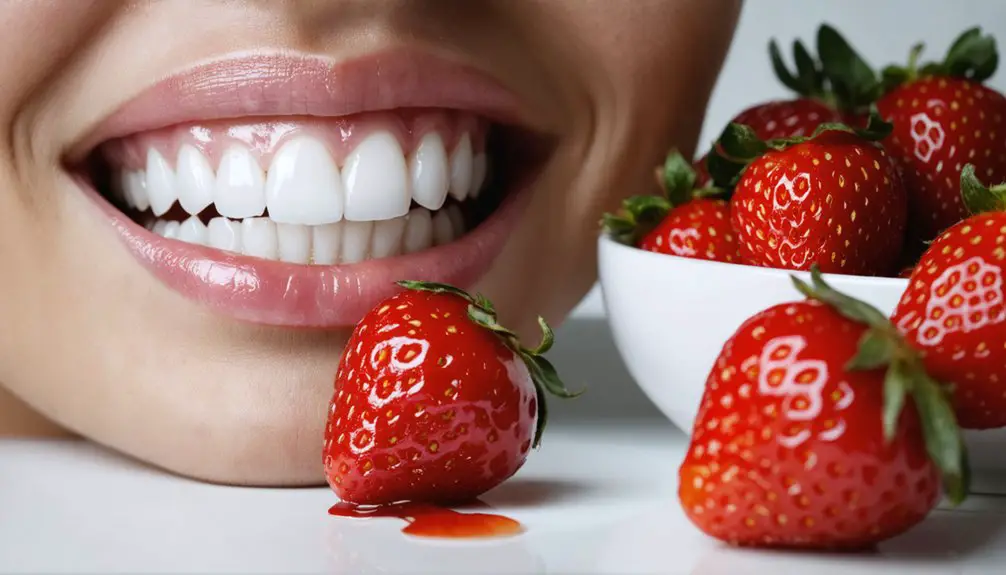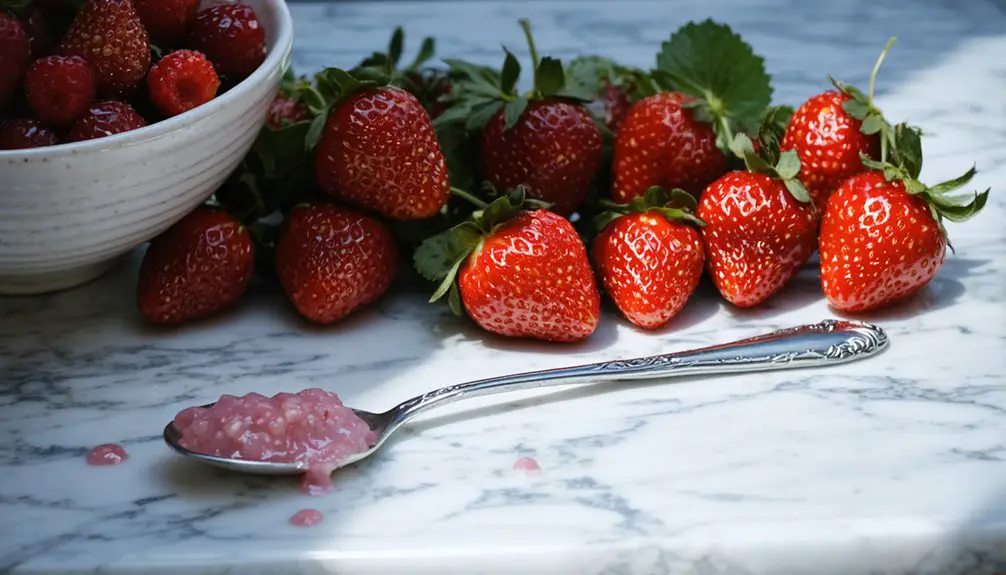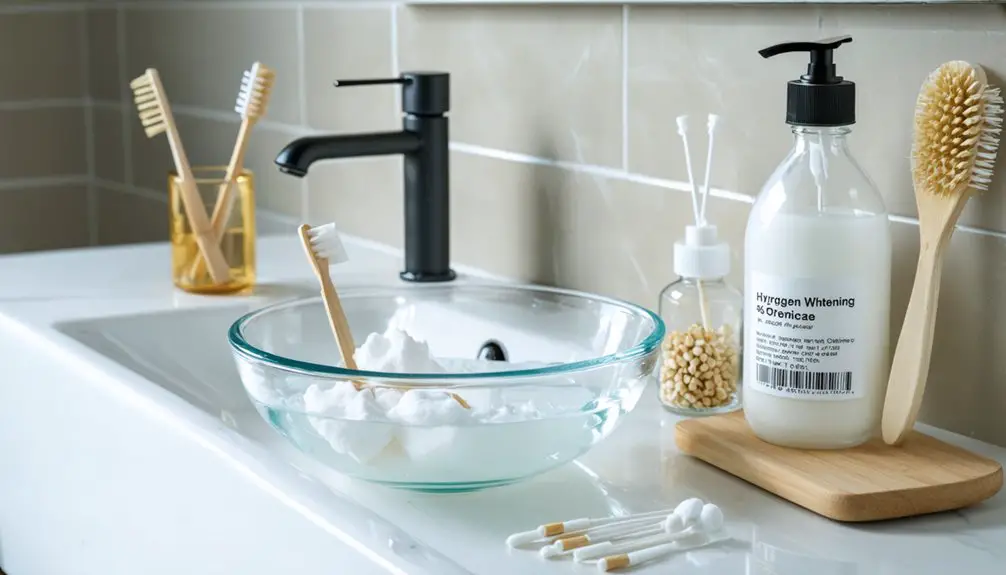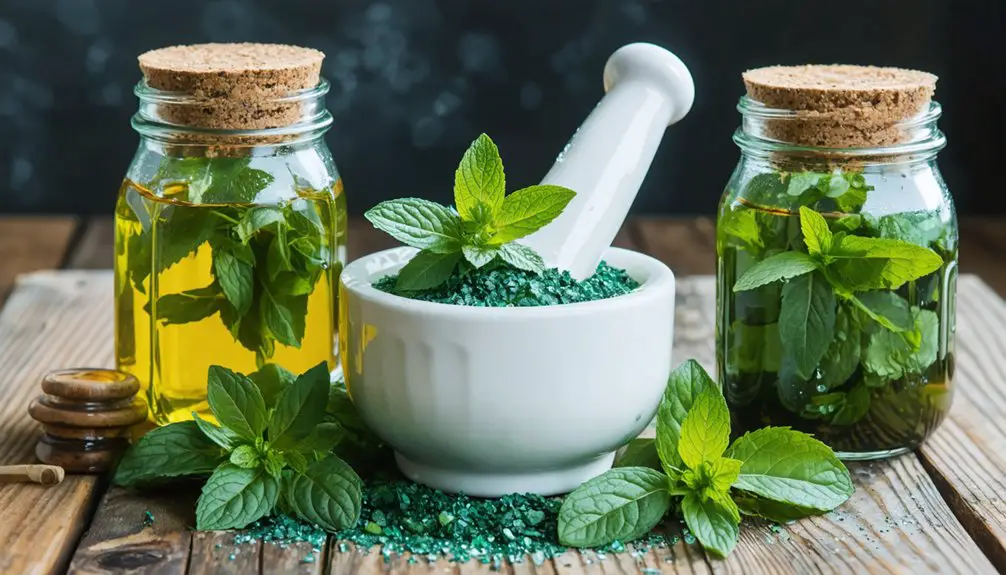You can naturally whiten your teeth using a simple strawberry and baking soda mixture. Mash one ripe strawberry with ½ teaspoon of baking soda until smooth, then apply the paste to clean teeth using gentle circular motions. Leave on for 3-5 minutes, then rinse thoroughly. Repeat no more than twice weekly to protect your enamel. While results are modest compared to professional treatments, this DIY method leverages malic acid’s natural whitening properties. Discover the science and safety guidelines for best results.
Key Takeaways
- Mix mashed ripe strawberries with equal parts baking soda to create a natural whitening paste for teeth.
- Apply the strawberry mixture gently with a soft toothbrush for 3-5 minutes, no more than twice weekly.
- Rinse thoroughly after treatment and wait before brushing to protect tooth enamel from acid damage.
- Expect visible results after 10-14 days of consistent use, primarily from surface cleaning rather than deep enamel whitening.
- Monitor tooth sensitivity and maintain regular oral hygiene, including fluoride toothpaste use between treatments.
The Science Behind Strawberry Teeth Whitening
Although strawberries have gained popularity as a natural teeth whitening remedy, their effectiveness stems primarily from malic acid and polyphenols. The malic acid works as a mild astringent and oxidizing agent, lowering oral pH to around 3-4, which helps remove surface stains from your teeth.
Meanwhile, polyphenol effects contribute to both whitening and antimicrobial properties, helping reduce bacteria that cause plaque and discoloration. A clinical examination and review of dental history is essential before whitening, regardless of whether you’re using natural or commercial methods.
While these natural compounds can provide modest whitening results, they’re considerably less effective than professional treatments like carbamide peroxide. Studies show minimal tooth whitening can be achieved through strawberry treatments alone.
It’s essential to recognize that strawberries’ acidic nature can potentially soften your enamel if used improperly. For safe application, you’ll need to carefully control exposure time and frequency to prevent enamel damage while still achieving some whitening benefits.
Essential Ingredients and Materials Needed
Success in DIY strawberry teeth whitening depends on gathering the right combination of natural ingredients and tools.
You’ll need fresh, ripe strawberries, as they contain the most active malic and ellagic acids for ideal whitening. When making your selection, choose bright red, fully ripened berries for maximum effectiveness.
Essential tools include a small mixing bowl, fork or masher for creating the pulp, and a soft-bristled toothbrush for application.
Being part of roses, strawberries offer unique properties for natural dental care.
The baking soda ratio should be approximately equal parts with your mashed strawberry pulp to create an effective paste while balancing acidity.
You’ll also want to keep a timer handy to guarantee you don’t exceed the recommended 5-minute application time.
Research shows that 100% strawberry extract can effectively whiten teeth within five days of regular use.
Remember to have water and mouthwash ready for thorough rinsing afterward to protect your enamel.
Step-by-Step Preparation Guide
Now that you’ve gathered your ingredients and tools, let’s walk through the precise steps of preparing your strawberry whitening treatment.
Begin with strawberry selection, choosing a fully ripe berry that’s bright red and slightly soft to guarantee ideal malic acid content. The strawberry’s natural ascorbic acid helps lift stains effectively. Thoroughly mash or puree the strawberry until you achieve a smooth consistency, then mix in ½ teaspoon of baking soda until well combined. Use this mixture only once or twice weekly to protect your enamel from damage.
Before applying your paste, prepare your teeth by brushing with regular toothpaste and flossing to remove debris. Rinse your mouth with water and gently pat your teeth dry with a clean cloth.
For the best paste consistency, mix ingredients immediately before use and verify there are no lumps that could affect even application. This preparation method maximizes the treatment’s whitening potential while protecting your enamel.
Safe Application Methods and Timing
When applying your strawberry whitening treatment, proper timing and technique are essential for both safety and effectiveness. Limit your application timing to 5 minutes, and never use the treatment more than twice weekly to protect your enamel. Research shows that strawberry treatments can weaken tooth structure over time.
Apply the paste after meals using a soft toothbrush or your finger, but avoid bedtime applications unless you’ll brush afterward.
Mix ripe strawberries with a small amount of baking soda for gentle stain removal. The natural malic acid in strawberries helps lift surface stains while being gentler than commercial products. After treatment, rinse thoroughly and follow with fluoride toothpaste to help remineralize your teeth.
For ideal enamel protection, wait before brushing hard, as teeth are more vulnerable immediately after acid exposure.
Don’t combine this treatment with other whitening methods, and always floss afterward to remove any strawberry seeds between teeth.
Precautions and Best Practices
Following proper application methods, it’s equally important to understand key precautions for your strawberry whitening treatment.
For enamel protection, don’t brush your teeth immediately after applying the mixture, and limit treatments to avoid cumulative wear. Wait at least 48 hours between applications to protect your tooth surfaces. Current research shows that strawberries and other natural remedies only provide surface stain removal. Since teeth are more susceptible right after whitening, avoid dark berries and deeply pigmented fruits for optimal results.
For sensitivity management, consider using desensitizing products containing fluoride or potassium nitrate before starting your treatment. If you experience prolonged sensitivity or gum irritation, consult your dentist immediately.
After treatment, avoid acidic foods, coffee, tea, and dark beverages for at least 48 hours. Maintain good oral hygiene but use gentle brushing techniques, and stay hydrated to support your natural saliva production, which helps protect your enamel.
Natural Alternatives and Combinations
Understanding natural teeth whitening alternatives can expand your treatment options beyond strawberries alone.
You’ll find several natural food options that offer enzyme benefits for stain removal. Consider incorporating pineapple and papaya, which contain proteolytic enzymes that effectively break down protein-based stains on your teeth’s surface.
For enhanced results, you can combine different natural approaches. Try watermelon or dairy products to increase saliva production, which naturally cleanses your teeth.
Coconut oil pulling and activated charcoal treatments offer additional whitening potential. When creating combinations, pair acidic fruits with neutralizing agents like baking soda to protect your enamel.
Remember that while these natural alternatives are gentler than commercial products, they’ll provide more subtle, gradual results that can complement your regular oral care routine.
Expected Results and Maintenance

You’ll notice subtle whitening effects from strawberry treatments within a few applications, though results are typically less dramatic than professional methods and may fade within months.
To maintain any visible improvements, you’ll need consistent reapplication while carefully monitoring your enamel health, as excessive use can lead to sensitivity.
Your best strategy combines occasional strawberry treatments with good oral hygiene practices and avoiding stain-causing foods and beverages.
Realistic Whitening Timeline
While many people hope for quick results from strawberry teeth whitening treatments, the reality is far more modest than advertised.
Common whitening myths suggest visible changes within days, but scientific evidence shows no real enamel whitening occurs. Instead, you’ll notice temporary brightening from plaque and debris removal after 10-14 days of consistent use.
To set realistic treatment expectations, understand that any perceived whitening comes from surface cleaning rather than true bleaching effects.
Unlike professional treatments that produce noticeable changes within days, strawberry applications won’t alter your tooth’s intrinsic color. You’ll need to maintain regular oral hygiene to preserve the minimal brightening achieved.
If you’re seeking significant whitening results, consider consulting a dental professional for more effective treatment options.
Maintaining Long-Term Results
The key to sustaining any tooth-brightening effects from strawberry treatments lies in proper maintenance and realistic expectations.
You’ll need to commit to thorough daily oral hygiene, including twice-daily brushing with fluoride toothpaste and regular flossing, as your foundation for long-term care.
For ideal enamel protection, wait at least a week between strawberry applications and avoid brushing immediately afterward.
Support your results by using whitening toothpaste, limiting stain-causing foods, and scheduling regular dental cleanings.
Remember that strawberry treatments provide mostly temporary effects through surface stain removal rather than deep whitening.
To maximize benefits, incorporate calcium-rich foods in your diet and maintain good hydration levels.
Consider strawberry treatments as just one component of your extensive oral care routine.
Professional Insights and Expert Tips
You’ll find that dental experts recommend limiting strawberry whitening treatments to once or twice weekly to protect your enamel while still achieving gradual results.
For ideal safety and effectiveness, always mix fresh strawberry paste with a small amount of baking soda and apply it gently to your teeth for no more than five minutes.
Research indicates you should follow each treatment with thorough rinsing and regular fluoride toothpaste use to maintain enamel strength and prevent sensitivity.
Dental Expert Safety Guidelines
Professional dental experts strongly caution against using DIY strawberry whitening treatments without proper consultation, citing significant risks to dental health.
While strawberries contain natural acids that may temporarily remove surface stains, their acidity can compromise whitening safety and damage your tooth enamel when used improperly.
To protect your dental health when considering strawberry-based treatments, experts recommend:
- Consult your dentist before starting any DIY whitening regimen
- Wait until you’re at least 18 years old to minimize pulp damage risk
- Avoid combining strawberries with abrasive substances like baking soda
- Limit frequency of application to prevent enamel erosion
- Rinse thoroughly after treatment to neutralize acidic residue
Consider professional whitening options under dental supervision for safer, more effective results that won’t compromise your enamel integrity.
Best Application Techniques Revealed
Successfully implementing a DIY strawberry whitening treatment requires careful attention to preparation and application techniques.
To achieve ideal results, mash fresh strawberries into a smooth pulp and combine with just enough baking soda to create a paste that’s thick but spreadable.
For the most effective methods, start with clean, dry teeth and apply the mixture using gentle circular motions with a soft toothbrush or your finger. Verify you’re covering all visible tooth surfaces evenly.
Leave the paste on for 3-5 minutes – no longer, as extended exposure may harm your enamel. After treatment, rinse thoroughly with water and follow with fluoride toothpaste to neutralize acids.
Remember to limit applications to 2-3 times weekly and monitor for any sensitivity. These careful application techniques will help you achieve gradual whitening while protecting your dental health.
Research-Backed Treatment Recommendations
Recent scientific studies have revealed three key recommendations for safe and effective strawberry whitening treatments.
Research demonstrates that when properly applied, strawberry benefits include natural whitening through malic acid while protecting teeth aesthetics.
- Mix 10g of mashed ripe strawberries with baking soda for ideal whitening results
- Apply the mixture for no more than 2-3 minutes to prevent enamel erosion
- Rinse thoroughly and brush gently after treatment to remove residual acid
- Use treatments intermittently, not daily, to maintain enamel integrity
- Consult your dentist before starting any whitening regimen
Clinical trials confirm these research-backed guidelines maximize whitening while minimizing sensitivity.
Frequently Asked Questions
Can Strawberry Teeth Whitening Remove Deep Stains From Smoking or Coffee?
Strawberry enzymes won’t effectively remove your deep stains from smoking or coffee. While they can help with minor surface stain removal, you’ll need professional whitening treatments for significant results on deep discoloration.
Is Strawberry Whitening Safe for Children and Teenagers to Try?
Like walking on thin ice, strawberry whitening isn’t safe for young smiles. Due to serious safety concerns, you shouldn’t try any teeth whitening until after age 15, following professional age recommendations.
Will Strawberry Whitening Affect Existing Dental Work Like Crowns or Veneers?
You won’t see whitening effects on crowns or veneers since they don’t respond to strawberry treatments. While it likely won’t cause crown sensitivity or veneer discoloration, consult your dentist first.
How Soon After Professional Dental Cleaning Can I Try Strawberry Whitening?
For ideal timing, you’ll need to wait 1-2 weeks after your professional cleaning before trying strawberry preparation. This delay protects your temporarily sensitive enamel from the fruit’s natural acids.
Does Freezing or Heating Strawberries Change Their Whitening Effectiveness?
You’ll get better whitening results using fresh strawberries since freezing effects slightly reduce potency when thawed. Avoid heating altogether, as it degrades malic acid and offers no heating benefits for whitening.
References
- https://www.jaxdentalstudio.com/do-strawberries-whiten-teeth
- https://pmc.ncbi.nlm.nih.gov/articles/PMC10011378/
- https://valleyinternational.net/index.php/ijmsci/article/view/3582
- https://www.colgate.com/en-us/oral-health/teeth-whitening/strawberry-teeth-whitening-and-other-weird-whitening-methods
- https://www.jacksonfamilydentistrywi.com/post/do-strawberries-whiten-teeth
- https://medwinpublishers.com/OAJDS/potency-of-acid-content-in-local-and-imported-strawberry-fruit-extract-fragaria-x-ananassa-as-natural-ingredients-for-teeth-whitening.pdf
- https://www.natrusmile.com/blogs/news/do-strawberries-whiten-teeth
- https://pmc.ncbi.nlm.nih.gov/articles/PMC10024105/
- https://www.ada.org/resources/ada-library/oral-health-topics/whitening
- https://www.southtampasmiles.com/can-strawberries-whiten-your-teeth/



